



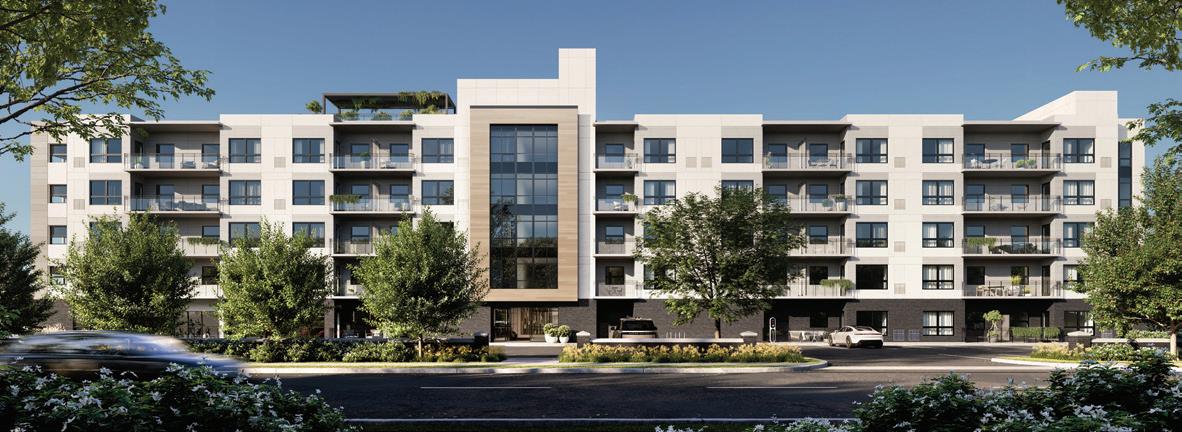

















































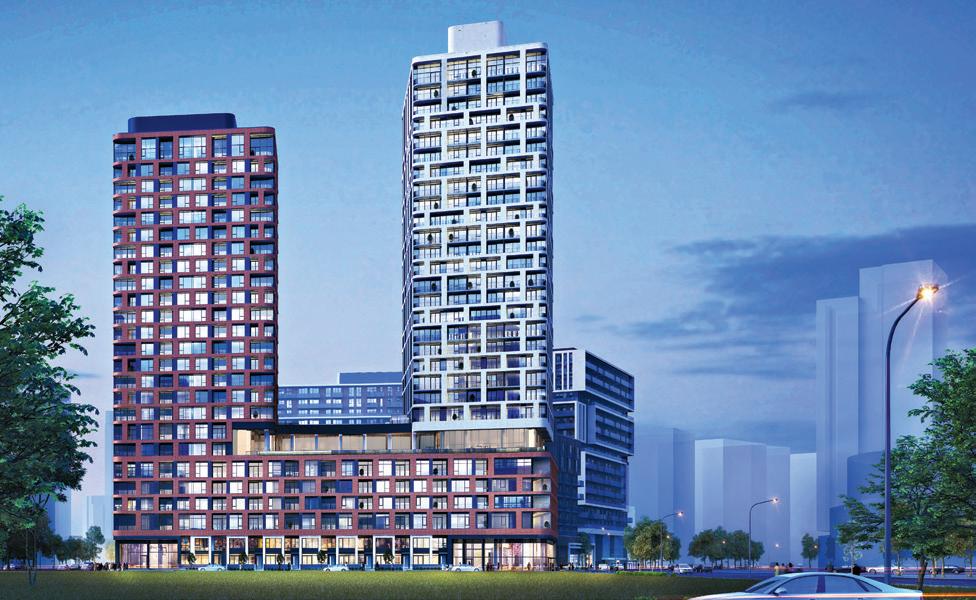































































WAYNE KARL EDITOR-IN-CHIEF
Condo Life Magazine
EMAIL: wayne.karl@nexthome.ca
TWITTER: @WayneKarl
As we and many of our columnists and industry experts have written many times in recent months – in fact, quite literally, years – the homebuilding industry in Toronto, the GTA, throughout Ontario and indeed Canada needs more and better government involvement.
Not just words or platitudes, but action.
As Richard Lyall, president of the Residential Construction Council of Ontario, wrote in our Builder Bites newsletter (buildingexcellence.ca), “The future of the residential construction industry – and our economic future –depends on the action we take today. The next several months are critical in determining how well we rise after the fall.”
No sooner had he made this recent comment, the federal government on Sept. 14 announced the Build Canada Homes program, a new $13-billion plan to address the supply and affordability issues facing the homebuilding industry in Canada (see page 8).
It’s early days yet, but initial feedback from industry and other related bodies is positive.
This, from the important GTA homebuilding organization, the Building Industry and Land Development Association (BILD): “While many details and questions remain, some clarity has emerged. In alignment with the advocacy by BILD and the Large Urban Centre Alliance, Build Canada Homes (BCH) is expected to partner with industry and other stakeholders to deliver affordable housing at scale and speed. Build Canada Homes was said to offer flexible, financial incentives, approve large portfolio projects, and leverage public lands for housing so projects are derisked and private builders can focus on building.
“As BILD and the Large Urban Centre Alliance had been advocating for, BCH will focus primarily on non-market housing, as part of a national effort to increase housing construction.”
BILD is now in the process of organizing a member briefing by federal officials on the new program.
Good news for Toronto and GTA in the BCH initiative is that to lead the mandate, Carney appointed Ana Bailão as CEO. Bailão knows housing in the city, having served for more than a decade on Toronto City Council –including as Deputy Mayor from 2017 to 2022, as Chair of the Planning and Housing Committee and on the board of Toronto Community Housing. Most recently, she has served as the Head of Affordable Housing & Public Affairs with the private developer Dream Unlimited Corp.
Adds BILD, “We are very pleased that Ana Bailão has been selected as the CEO of BCH. We look forward to continuing to work with Ana in her new role.”
This is all an important first step from Ottawa, and with more to come, it’s a great start.














An award-winning interior designer, Mariam Aboutaam is Director, Sales and Marketing, Interior Design at Kylemore, Markham, Ont., a builder known for master-planned communities and luxury homes. kylemoreliving.com.
Jesse Abrams is Co-Founder at Homewise, a mortgage advisory and brokerage firm based in Toronto. thinkhomewise.com
Elechia Barry-Sproule is President of the Toronto Regional Real Estate Board (TRREB) and Broker/Owner of Red Apple Real Estate Inc. She is committed to mentoring and supporting real estate professionals across the industry. trreb.ca.
Mike Collins-Williams, RPP, MCIP, is CEO West End Home Builders’ Association. westendhba.ca.
Debbie Cosic is CEO and founder of In2ition Realty. She has overseen the sale of more than $15 billion worth of real estate. With Debbie at its helm, In2ition has become one of the fastest-growing and most innovative new home and condo sales companies. in2ition.ca
Barbara Lawlor is CEO of Baker Real Estate Inc. A member of the Baker team since 1993, she oversees the marketing and sales of new home and condominium developments in the GTA, Vancouver, Calgary and Montreal, and internationally in Shanghai. baker-re.com
Linda Mazur is an award-winning, nationally publicized designer and Principal of Linda Mazur Design Group. With almost two decades of experience this in demand multi-disciplinary design firm is known for creating relaxed, stylish spaces and full-scale design builds within Toronto, the GTA and throughout Canada. lindamazurdesign.com @LindaMazurGroup
Ben Myers is the President of Bullpen Consulting, a boutique residential real estate advisory firm specializing in condominium and rental apartment market studies, forecasts and valuations for developers, lenders and land owners. Contact him at bullpenconsulting.ca and @benmyers29 on Twitter.
Dave Wilkes is president and CEO of the Building Industry and Land Development Association (BILD), the voice of the home building, land development and professional renovation industry in the GTA. For the latest industry news and new home data, follow BILD on Twitter at @bildgta or visit bildgta.ca
SENIOR VICE-PRESIDENT, SALES, NEXTHOME
Hope McLarnon 416.708.7987 hope.mclarnon@nexthome.ca
SENIOR MEDIA CONSULTANT
Amanda Bell 416.830.2911 amanda.bell@nexthome.ca
EDITORIAL DIRECTOR
Amanda Pereira
EDITOR-IN-CHIEF – GREATER TORONTO AREA
Wayne Karl wayne.karl@nexthome.ca
CONTRIBUTORS
Mariam Aboutaam, Jesse Abrams, Elechia Barry-Sproule, Mike Collins-Williams, Debbie Cosic, Barbara Lawlor, Linda Mazur, Ben Myers, Dave Wilkes
EXECUTIVE MEDIA CONSULTANTS
Jacky Hill, Michael Rosset
VICE-PRESIDENT, MARKETING – GTA
Leanne Speers
MANAGER CUSTOMER SALES/SERVICE
Marilyn Watling
SALES & MARKETING CO-ORDINATOR
Gary Chilvers
BUSINESS DEVELOPMENT MANAGER
Josh Rosset
DISTRIBUTION distributionteam@nexthome.ca
ACCOUNTING INQUIRIES
accountingteam@nexthome.ca
DIRECTOR OF PRINT MEDIA
Lauren Reid–Sachs
VICE-PRESIDENT, PRODUCTION – GTA Lisa Kelly
PRODUCTION MANAGER – GTA Yvonne Poon
GRAPHIC DESIGNER & PRE-PRESS COORDINATOR
Hannah Yarkony

Published by nexthome.ca
Advertising Call 1.866.532.2588 ext. 1 for rates and information. Fax: 1.888.861.5038
Circulation Highly targeted, free distribution network aimed at real estate buyers using street level boxes, racking and Toronto Star in-home delivery.
Canadian subscriptions 1 year = 13 issues – $70 (inc. HST). Canada Post – Canadian Publications Mail Sales Product Agreement 40065416.
Copyright 2025 All rights reserved. All copyright and other intellectual property rights in the contents hereof are the property of NextHome, and not that of the individual client. The customer has purchased the right of reproduction in NextHome and does not have the right to reproduce the ad or photo in any other place or publication without the previous written consent of NextHome.
Editorial Submissions from interested parties will be considered. Please submit to the editor at editorial@nexthome.ca.
Terms and Indemnification
Advertisers and contributors: NextHome is not responsible for typographical errors, mistakes, or misprints. By approving your content and/ or submitting content for circulation, advertisers and contributors agree to indemnify and hold harmless NextHome and its parent company from any claims, liabilities, losses, and expenses (including legal fees) arising out of or in connection with the content provided, including but not limited to any claims of copyright infringement, unauthorized reproduction, or inaccuracies in the content. Advertisers acknowledge that they have the necessary rights, permissions, and licenses to provide the content for circulation, and they bear full responsibility for the content’s accuracy, legality, and compliance with applicable laws upon approval. Contributors acknowledge NextHome reserves the right to omit and modify their submissions at the publisher’s discretion.
The federal government has launched Build Canada Homes, a new $13-billion program to address the supply and affordability issues facing the homebuilding industry in Canada.
Build Canada Homes is intended to help fight homelessness by building transitional and supportive housing –working with provinces, territories, municipalities and Indigenous communities. It will build affordable and community housing for lowincome households, and partner with private market developers to build affordable homes for the Canadian middle class.
“Canada’s new government is relentlessly focused on bringing down housing costs, says Prime Minister Mark Carney. “Central to that mission is rapidly scaling up the supply of homes. Build Canada Homes will transform the way government works with the private sector to build. We will create an entirely new housing industry using Canadian technology, Canadian worker, and Canadian resources – and give builders the tools they need to build more, build sustainably, and build at scale.”
Build Canada Homes will transform public-private collaboration and deploy modern methods of construction, as it catalyzes the creation of an entirely new Canadian housing industry. It will leverage
public lands, offer flexible financial incentives, attract private capital, facilitate large portfolio projects, and support modern manufacturers to build the homes that Canadians need, the government says.
The initiative is intended to bring federal lands, faster approvals and strong incentives to the table. The private sector will bring construction capacity, innovation, supply chains and financing.
• Partner with industry, other orders of government and Indigenous communities to build affordable housing at scale and at speed. As the federal government’s new onestop-shop for affordable housing, Build Canada Homes will make it easier and simpler for builders to access the resources needed to build new homes, faster. An initial investment of $13 billion will enable financing, provide land and help builders get big projects off the ground. It will offer flexible, financial incentives, approve large portfolio projects and leverage public lands for housing so projects are derisked and private builders can focus on building.
• Deploy capital, create demand and harness innovative housing technologies to build faster and more sustainably. Build Canada Homes will place an intense focus on using cost-efficient and modern methods of construction such as factory-built, modular and mass timber. Through bulk procurement and long-term financing, Build Canada Homes will mainstream these advanced methods of construction – with the potential to cut building timelines by up to 50 per cent, reduce costs by as much as 20 per cent, and lower emissions by approximately 20 per cent during
construction. To supplement these efforts, Build Canada Homes will prioritize low-carbon materials, low-carbon technologies and efficient design.
• Adopt the government’s new Buy Canadian policy and prioritize projects that use Canadian lumber and other Canadian materials. With the Buy Canadian policy, Build Canada Homes will channel demand through Canadian industries – from lumber and steel to aluminum and mass timber – strengthening domestic supply chains, scaling up a home-grown housing industry, and creating high-paying careers across the country.
To lead the mandate, Carney appointed Ana Bailão as CEO of Build Canada Homes. Bailão served for more than a decade on Toronto City Council – including as Deputy Mayor from 2017 to 2022, as Chair of the Planning and Housing Committee and on the board of Toronto Community Housing. While on City Council, Bailão spearheaded the creation of Housing Now, which uses city lands to build housing. Most recently, she served as the Head of Affordable Housing & Public Affairs with the private developer Dream Unlimited Corp.
“Affordable housing has always been more than policy – it’s a personal mission, says Bailão. “From my time in public office to my work in the private sector, I’ve seen firsthand how safe, stable housing transforms lives. At Build Canada Homes, we are bringing together government, industry and communities to build homes faster, smarter and more sustainably. We’re not just building units – we’re building opportunity, dignity and a future where everyone in Canada has access to the homes they need – and deserve.”





Hundreds of prospective homebuyers, investors and industry professionals came together Sept. 13 and 14 at the New Home + Condo EXPO, hosted by NextHome at the Metro Toronto Convention Centre in Toronto.
The event was a hub of energy and opportunity, connecting buyers with some of the GTA’s top builders and developers.
From exclusive incentives to insider advice, the EXPO gave attendees a chance to explore the latest projects shaping Toronto’s housing market.
We’d like to thank everyone who joined us and to help make the EXPO a success – from our signature exhibitors to attendees who came ready to discover their next home.
COULDN’T MAKE IT? STAY TUNED FOR DETAILS ON OUR NEXT EVENT

THANK YOU TO OUR EXHIBITORS!



Visit newhomeandcondoexpo.ca for








Following a period characterized by consumer uncertainty and a pull-back of buyers during the first quarter of 2025, the Canadian housing market may be turning a new leaf this fall.
According to ReMax Canada’s 2025 Fall Housing Market Update, improved affordability and a boost in inventory levels could entice cautious buyers back into action.
According to data supplied by ReMax brokers and agents, home sales declined year-over-year in 62 per cent of markets analyzed between Jan. 1 and July 31, 2025, largely reflecting the economic uncertainty being felt across the country. Meanwhile, residential price trends varied regionally, rising across Atlantic Canada and the Prairies, while declining in major urban centres in Ontario and British Columbia.
In contrast to the inventory shortfall that defined many markets in 2024, 2025 saw listings increase in Ontario and British Columbia, signaling a shift to buyers’ market conditions. Meanwhile, tighter inventory levels in the Prairies and Atlantic Canada indicate conditions favouring sellers.
“Canada’s real estate landscape paints a complex picture of resilience and caution, influenced by regional nuances and continued economic uncertainty,” says Don Kottick, president of ReMax Canada. “From seller-driven markets across much of
Atlantic Canada and the Prairies, to buyer-friendly conditions in Ontario and BC, the nation’s housing market reflects a delicate balance. What hasn’t changed is that Canadians see value in homeownership, and an experienced, professional real estate agent can help buyers and sellers tailor their strategies to better set themselves up for success, regardless of market conditions.”
In 2024, first-time buyers drove sales in the majority of markets across Canada. In a notable shift, ReMax brokers and agents report that first-timers have taken a back seat in today’s market, with families, new Canadians and retirees driving the bulk of activity in 2025. According to a Leger survey commissioned by ReMax Canada, seven per cent of Canadians say they intend to buy their first home within the next year. This group is trending older, with many now entering the market in their late-20s to 40s, reflecting both broader affordability challenges and the increasing complexity of entering the market.
The Leger survey also reveals that today’s first-time homebuyers are financially varied, some entering with strong savings and others relying on more creative strategies to get their foot in the door. Twenty-eight per cent of those planning to buy their first home in the next 12 months say they have saved at least 20 per cent for their down payment, while 33 per cent have saved 15 per cent or more, and 13 per cent have saved at least 10 per cent. Only one in 10 Canadians say they have been gifted money to help them buy a home, suggesting many are finding their own way, such as through disciplined saving, or co-ownership models and other non-traditional approaches.
While 12 per cent of Canadians say they plan to purchase a home in

the next year, many are watching the market closely for the right moment to act. Among this group, 68 per cent say a five- to 10-per-cent drop in property prices would make a meaningful difference in their ability to enter the market, while 64 per cent say they’d feel ready if interest rates fell by 0.5 to one per cent.
“These insights paint a picture of first-time buyers who are older, more financially prepared in some cases, but still navigating significant headwinds and waiting for the market to meet them halfway,” says Kottick.
As the Canadian housing market moves toward recovery, a wave of optimism is emerging. According to Leger survey insights, 46 per cent of Canadians are hopeful that the federal and provincial governments’ renewed commitment to building more housing will enhance affordability within the next three to five years. This growing confidence signals a brighter outlook, with government initiatives poised to play a critical role in stabilizing and strengthening the housing landscape, offering renewed hope for prospective buyers and a resilient market ahead.

Collingwood Quay: The next wave in waterfront condo living
If you haven’t been to Collingwood lately, you’re missing out. Blessed with a beautiful location at the southern point of Georgian Bay, just 160 kms north of Toronto, this four-seasons paradise now boasts elevated homeowning and lifestyle opportunities. Chief among them is Collingwood Quay, a six-storey, 100-suite boutique condo from FRAM + Slokker. Catch up between issues at & enjoy these popular stories nexthome.ca
Weathering the storm: Why real estate downturns are only temporary
If you’re feeling uneasy about buying a home right now, you’re not alone. We haven’t seen a market dip like this since the early 1990s. But here’s the good news: Downturns don’t last forever, and the rebound always comes.

Time to act
You have to wonder sometimes how well governments actually pay attention. When it comes to housing, and the need to build more new homes in the Greater Toronto Area and elsewhere in Ontario, the answer to that question seems to be… not very much, or at least not closely.

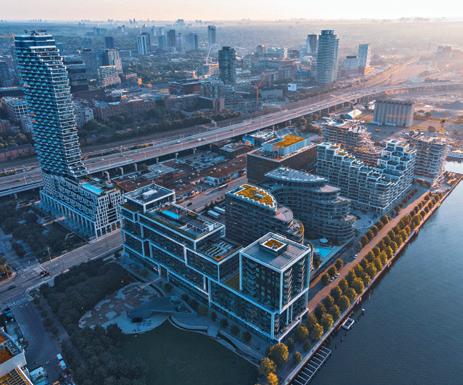
GTA records strongest July homes sales in four years: TRREB
The Greater Toronto Area experienced the best home sales result for the month of July since 2021, according to the latest statistics from the Toronto Regional Real Estate Board. Sales were also up relative to listings, suggesting a modest tightening in the market compared to last year.

Lighting as a design foundation, not just a finishing touch
Lighting should never be an afterthought. Before drywall is installed or any millwork is produced, create an electrical plan that addresses both practical and decorative needs for every room. While decorative lighting elements are introduced later in the design process, their placement and purpose are accounted for from the beginning.
Visit nexthome.ca



If you are a prospective buyer or investor trying to make sense of the next few years, here is the short version: We are likely going to be flush with inventory over the next couple of years, but new housing completions will slow considerably starting in early 2028.
Supply and demand are undefeated. When housing availability is high, prices and rents shrink; when inventory is in short supply, prices and rents increase. Be careful when listening to hot takes from wannabe housing analysts who manipulate data and peddle outrage.
What are the smartest voices in the industry saying and doing? On the 91st episode of Toronto Under Construction, three seasoned operators (Matt Kingston of H&R REIT, Jeremiah Shamess of Colliers, and Joshua Marlowe of Berkshire
Axis) offered a clear window into how real developers are behaving. Rents for newer purpose-built rentals in downtown Toronto have eased as new product becomes available. Incentives are up, and pro formas are tight. Kingston noted that it is not much cheaper to build than it was three years ago, even with improved financing options. All of those condo sites will not be converted to rental as many people had hoped. Land trading reflects the caution: Deal counts are low, with only the very best located and correctly priced sites moving,

according to Shamess. If developers are not buying sites today, that is just another sign that the market will be undersupplied for many years to come.
If you want balanced discussion that prioritizes evidence over theatrics, put Toronto Under Construction in your queue, alongside Hogtown, Commercial Real Estate Podcast, Working Capital, AFIRE, The Real Estate Espresso Podcast, Real Estate Development Insights, and The Vancouver Real Estate Podcast. If you want interesting long-form content, where the goal of the host is not cheap virality, these real estate podcasts are a good place to start.
If you have spent some time listening to those podcasts and are still not buying the supply and demand narrative, have a read over the data story below on why rents paused, and why they are likely to re-accelerate.
Begin with first principles: Vacancy and rent growth move in opposite directions. In the Toronto CMA, condo rentals have run at sub-twoper-cent vacancy most of the past two decades, while purpose-built vacancy spiked to 4.6 per cent in 2021 during the pandemic, and then tightened back to 1.4 per cent in 2023 before ticking up to 2.5 per cent last year. When vacancy dips below two per cent, rents typically rise; when it rises above about four per cent, rents flatten or fall. That pattern has held for decades.
What changed in 2023 and 2024 was supply. After a decade averaging roughly 13,000 new rentals annually (about 10,000 investor-owned condos added to the rental pool and 3,000 new purpose-built units starting occupancy), the industry accelerated deliveries, an outcome of record and near-record preconstruction sales in 2019, 2021 and early 2022. About 22,000 net new rentals were delivered in 2023, then about 30,000 in 2024. Even with that wave, rents still rose in 2023 before moderating to a growth rate of about one per cent in 2024,
according to data from Canada Mortgage and Housing Corp. The reason rents did not fall further is the deep undersupply built up over the prior decade, combined with latent demand from households that delayed moving out on their own.
Looking ahead, the pipeline tells the tale. Because most new rental supply comes from newly completed condos being rented by investors, the collapse in new condo sales (from nearly 30,000 in 2021 to less than 5,000 in 2024) sets up a sharp drop in completions after the 2025–26 bulge. Under construction data points to fewer than 11,000 condo completions in 2027 and an almost inconceivably low 2,300 in 2028. Even assuming purpose-built starts continue, total new rental additions are projected at roughly 31,000 in 2025, 19,750 in 2026, 17,500 in 2027, about 8,000 in 2028, and potentially less than 6,000 in 2029.
Translate that into rent expectations as projected by Bullpen Consulting: Modest growth of two to three per cent in 2027 as supply slows, and then accelerating to the 5.5- to seven-per-cent range in 2028 and 2029 when completions fall far short of demand.
For end-users, tenants and occupiers: If you are renting and flexible on timing, the next 12 to 18 months are likely the best window to secure favourable terms, especially in buildings offering incentives. If you are buying a new home, the near-term pricing outlook is mixed. Construction costs remain elevated, financing is tighter and land markets are thin. That usually means fewer launches, more careful product design and a focus on luxury projects with better margins and less pricesensitive buyers. The bigger driver of price appreciation in the future will be the supply drought that follows today’s slowdown in condo pre-sales. For investors: You must consider new home prices as they relate to the resale market. If there are deals that allow you to buy below the “retail price,” make sure you are
doing all your due diligence and reading your contract carefully. Housing analysis should be data-driven and evidence-led. Understanding data requires reading between the lines, and not always accepting the most basic conclusions. Be wary of content that leans on outrage, simple villains or one-variable explanations. Markets are complex systems: Immigration, household formation, interest rates, land use rules, construction capacity and investor behaviour all interact. The best analysts show their sources, admit uncertainty, update views as facts change and avoid grandstanding. If the person or people you listen to always think it is a great time to buy, or always think the market is crashing, chances are they are not being honest with you. They cater to an audience that just wants someone to validate how they are feeling, not tell them what is actually happening.
If you want grounded perspectives, follow practitioners who build, lease, finance or manage real assets, and podcasts that probe rather than provoke. The purpose is not to confirm a bias but to improve decisions. Over the next few years, supply dynamics, not catchy slogans or tired memes, will set the path for both rents and prices.
Do your own research, surround yourself with an experienced team and buy what you can afford. Good luck.
Ben Myers is the President of Bullpen Consulting, a boutique residential real estate advisory firm specializing in condominium and rental apartment market studies, forecasts and valuations for developers, lenders and land owners. Contact him at bullpenconsulting.ca and @benmyers29 on Twitter.
+MORE CONTENT ONLINE nexthome.ca

The way we buy homes has shifted dramatically. Entire communities can now be explored from a phone or tablet, with floorplans, finishes and pricing available at a tap. PropTech has made the pre-construction process faster, more accessible and more transparent. Yet, even as technology redefines the sales

journey, one thing has not changed: Real estate is still about people.
Today’s buyers expect the best of both worlds. They want the freedom to browse on their own, compare options and visualize possibilities with technology. But when it comes time to make one of the most important financial and emotional decisions of their lives, they still want the reassurance of a trusted advisor who can answer their questions and guide them through the details.
For agents and sales teams, success comes from knowing how to balance digital efficiency with genuine connection. Virtual tours, interactive pricing tools and digital contracts are powerful, but they cannot replace the value of an empathetic conversation. Technology can show the numbers, but it takes a skilled professional to explain what those numbers mean for a buyer’s lifestyle, long-term goals and peace of mind.
The strongest sales experiences bring both sides together. An app might let a buyer test-drive different layouts or compare finish packages, but the personal guidance of a sales representative helps them interpret what truly fits their vision for the future. Digital platforms enhance discovery, while human connection provides clarity and confidence. Together, they transform curiosity into commitment.
Developers see the benefits of this balance as well. PropTech platforms capture valuable insights into what buyers are searching for, which layouts resonate most and where demand is strongest. But data alone is not the answer. Those insights only matter when sales teams use them to shape meaningful
conversations, anticipate questions and address the emotions behind a purchase decision.
This is where trust is built.
Transparency through technology establishes credibility by putting information in the buyer’s hands, while personal interaction adds the confidence they need to move forward. It is not technology versus people. It is technology working hand in hand with people to create a complete and reassuring experience.
Looking ahead, the most successful new development projects will be the ones that integrate innovation with authentic human touchpoints. Buyers will always want digital convenience, but they will always value the relationships that make their purchase feel right. Developers and agents who embrace both sides of this equation will not just sell homes more effectively, they will create lasting relationships that build loyalty and word-of-mouth for years to come.
PropTech can open the door. It can inform, empower and accelerate the process. But it is the human connection that closes the sale and turns a purchase into a meaningful step toward someone’s future.
Tim Ng is the founder and CEO of ADHOC STUDIO and BLACKLINE, pioneering industry-leading digital solutions that merge real estate, art and technology to transform the sales experience. To explore ADHOC’s award-winning renderings and BLACKLINE’s innovative sales platform, visit adhocstudio.ca and blacklineapp.com.

I am continually amazed at how technological advances change the way people shop for houses and condominiums. Certainly, the Internet enabled potential purchasers to browse websites at any hour of the day or night to comparison shop. Now, we have a new tool that opens more doors when it comes to zeroing in on the perfect choice of a new home. En masse, people are taking advantage of the many benefits AI, or Artificial Intelligence, offers. Never have we been able to access so much detailed information in one place with only a few keystrokes. You can ask absolutely anything, from how much you can afford to spend on a new home, to how to read a floorplan, to what market trends indicate that an upand-coming neighbourhood is likely to skyrocket in value in the future.
There are several platforms you can use to access AI, such as ChatGPT, Gemini, Perplexity and Grok. These LLMs, or Large Language Models, produce human-style text based on massive collections of data. Whether you are just getting into AI or are an avid user already, here are some important things to remember.
• Understand that AI is a tool rather than a replacement for due diligence in the way of research. It is another way to help you gather information so you can make the best decision on what will likely be one of the biggest financial purchases of your life.
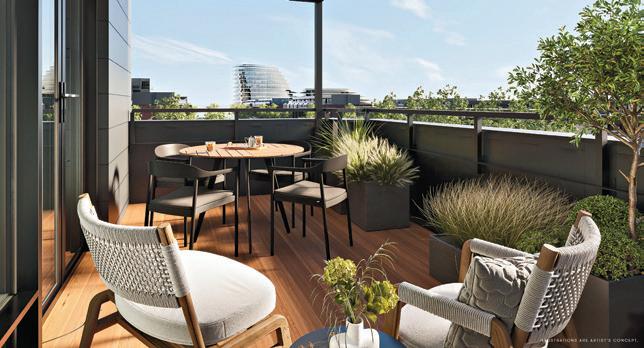
• Realize that ChatGPT and other platforms are only as good as the prompts or questions you offer them. Use this formula: action, details, format and tone.
– First, provide a good prompt that specifies up front what you would like to pursue, such as “I am looking to buy a new house or condo,” or perhaps “what professionals should I consult before I sign an Agreement of Purchase and Sale?”
– Then drill down with details to be specific. For example, are you looking for three-bedroom condos in a particular area or maybe current incentives being offered?
– After that, consider how you would like the information presented to you (paragraph form, bulleted list, email message, checklist).
– Finally, include the tone you seek (for example, if you’re a lawyer, you want advanced information, but if you’re a first-time buyer, you want more basic direction).
• When it comes to adding details or parameters for your personal new home search, keep in mind matters
such as location, price, builder reputation, amenities, incentives and square footages. If the response you get is not detailed enough, ask again and drill down to a deeper level. That’s one of the beauties of AI –the ability to customize your search by providing as many prompts as you want.
AI is certainly a hot topic today. Know how to use it effectively, and remember that like most of the Internet, it is not perfect. Your critically thinking brain and primary research are key when it comes to making your best decision. Do your fact-checking homework before you sign on the dotted line.
Barbara Lawlor is CEO of Baker Real Estate Inc. A member of the Baker team since 1993, she oversees the marketing and sales of new home and condominium developments in the GTA, Vancouver, Calgary and Montreal, and internationally in Shanghai. baker-re.com
+MORE CONTENT ONLINE nexthome.ca

JESSE ABRAMS

Mortgage rates are still in the higher range compared to a few years ago, and many buyers feel that pressure when they run the numbers on monthly payments. The good news is that most experts expect rates to keep dropping over the next year. At the same time, home prices in many parts of Canada are trending down. That creates an interesting moment for buyers: The chance to enter the market at a lower price point, even if today’s borrowing costs feel heavy.
When you are making a decision, it’s easy to focus only on the rate. A lower rate feels like a win because it lowers your payments right away. But the truth is that the rate is only one part of the full picture. The saying goes, you date your rate but you marry your amortization. Rates are temporary. You can refinance when they fall. The structure of your mortgage and the terms you agree to will stick with you for much longer.
A lower interest rate does help with monthly affordability, but it should not be the only thing guiding your choice. For example, if you buy a home today
at a reduced price compared to last year, that price cut could save you more than a temporary difference in rates. You also have the option to refinance later when rates fall.
Waiting for the “perfect” rate can backfire. If home prices climb again, you may end up paying more overall even if you lock in a slightly cheaper rate. Thinking short term about rates can lead you to miss the long-term savings that come from buying at a lower price today.
There are key features beyond the interest rate that will affect your financial future:

• Amortization period: This is the length of time you will take to pay off your mortgage. A longer amortization makes monthly payments easier to handle, but you will pay more interest over the life of the loan. A shorter amortization means higher monthly payments but far less interest overall. Picking the right balance is just as important as the rate itself.
• Prepayment options: These give you the chance to pay down your mortgage faster without facing penalties. Even adding small extra payments each year can save you thousands of dollars in interest and cut years off your mortgage term. Some lenders are far more flexible than others, so this is worth looking at closely.
• Portability: If you plan to move before your mortgage term ends, portability lets you take your mortgage with you. Without this feature, moving can mean breaking your mortgage and paying a large penalty. Having portability built in gives you peace of mind and more freedom in case life changes sooner than you expect.
• Penalties for breaking a mortgage: These penalties are often overlooked, but they can be
massive. Some lenders calculate penalties in a way that costs borrowers far more than others. Before signing, it is important to know exactly how penalties are calculated and what they might cost in real scenarios.
• Fixed vs variable: Choosing between a fixed or variable rate is another decision that goes beyond the headline number. A variable rate may look risky in a high-rate environment, but if rates drop over the coming years, it could pay off. A fixed rate locks in stability, but you might miss the benefit of falling rates. The right choice depends on your comfort level and financial plan.
If higher short-term rates are your main concern, it is worth stepping back and looking at the full landscape. Home prices are lower today, which can reduce your down payment needs and keep your overall debt smaller. Rates are also expected to continue dropping, which gives you a path to refinance into something more affordable down the road.
This means the bigger question is not just what your rate will be today.
It is whether the mortgage you choose sets you up with the right amortization, flexibility, and terms for the future. A great mortgage is the one that works for you not just this year but through the changes ahead.
Rates get the most attention, but they are only one piece of the puzzle. If you focus only on the number, you may miss the chance to save by buying at a lower price today and setting yourself up with a mortgage that supports your long-term goals. Remember, you date your rate, but you marry your amortization. The smartest move is to look past the short-term cost of borrowing and make sure your mortgage gives you the flexibility and protection you need for years to come.
Jesse Abrams is Co-Founder at Homewise, a mortgage advisory and brokerage firm. thinkhomewise.com



Downtown Markham isn’t just a development; it’s an unfolding story. This transformative project of epic scale not only reimagines what it means to live in a modern city, but is reshaping how other builders envision their own communities, serving as the defining model of how a modern city can look, feel and function.
Rising in the heart of York Region, this 243-acre master-planned community by The Remington Group is one of the most ambitious urban developments in North America. Here, the principles of smart growth, sustainability and design excellence converge to create a complete community – a place where people live, work, learn and thrive.
Already home to more than 4,500 residents, Downtown Markham is entering its next phase, with more than 2,525 new condominium homes soon to arrive. At full buildout, this vibrant core will feature approximately 20,000 residences, forming a dense yet human-scaled neighbourhood. Walkability, cultural amenities, retail destinations and educational anchors are
not afterthoughts – they are the foundation. This is city living with purpose, rooted in community values and shaped by long-term vision and careful planning.
Unlike many new communities, Downtown Markham places greenspace at its centre. An expansive, linear park system will run through the community and connect directly to the protected greenspace of the Rouge River Watershed, which ultimately connects to Rouge National Urban Park, one of the country’s most treasured natural landscapes.
This isn’t just about recreation –it’s about rethinking the relationship between the built environment and nature. It’s a place to jog or hike along groomed trails but also a place where that daily coffee becomes a stroll under the trees and alongside flowing water. Imagine evenings spent watching the sunset in the park instead of sitting in traffic. Here, in Downtown Markham, wellness and sustainability are seamlessly integrated into daily life, offering a lifestyle rooted in balance and connection.
Just steps away, York University’s Markham Campus (YUMC) brings a new dimension: Youthful energy, academic excellence and a futureforward mindset. The campus transforms the district into a centre of innovation and talent, offering residents not just proximity to learning, but access to an entire knowledge economy rooted in the very businesses that have made Markham the nation’s technology and life sciences hub. Beyond providing an educational resource, the campus represents a deliberate strategy in urban synergies: Pairing residential density with cultural vitality, employment opportunities and institutional presence.
In a climate where many residential real estate projects face challenges, Downtown Markham has proven remarkably resilient. Developments such as Gallery Square and Gallery Towers have achieved high occupancy rates. This stability is driven by a unique buyer profile: End-users and long-term investors who see value beyond speculation. They’re not investing in a property, but rather a community that suits a variety or lifestyles.
For families, professionals and entrepreneurs, the appeal of Downtown Markham is clear: A walkable urban core where lifestyle is the amenity. Shops, schools, offices, restaurants, parks, entertainment and cultural spaces are all at your doorstep. This is a neighbourhood built for the human experience.
Downtown Markham is also home to one of Canada’s most ambitious public art programs – a $35-million investment that weaves art into everyday life. From sculptures in public plazas to murals that transform streetscapes, art is part of the city’s DNA. Beyond the visual, this cultural framework extends into community life with music festivals, familyfriendly block parties and public gatherings that animate the streets and plazas. The iconic Pride of Canada Carousel further anchors this spirit of placemaking, serving not only as a beloved attraction but as a venue for community walks, birthdays and cultural celebrations.
Here, art is not ornamental but integral to placemaking, designed to shape how people experience and remember the city. Soon, a dedicated 20,00-sq.-ft. art gallery and event space will anchor this vision,
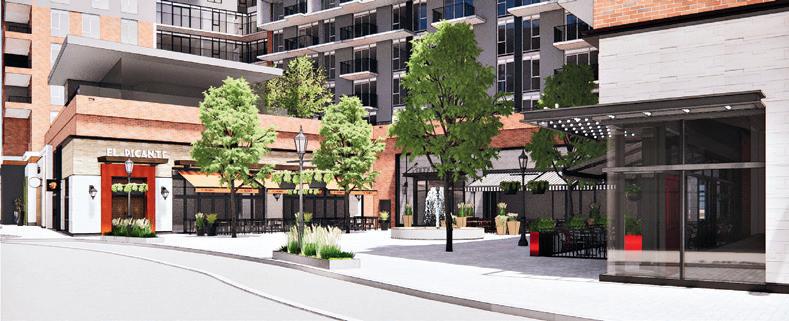
showcasing a curated collection acquired specifically for Downtown Markham. For The Remington Group, this commitment reflects more than aesthetics – it is a demonstration of the company’s long-term commitment to the communities it creates, ensuring stewardship continues well beyond construction, embracing its residence and visitors and enriching them with art and experiences that inspire, connect and endure.
For more than 75 years, The Remington Group has been shaping communities across Ontario. Now in its third generation of leadership, the developer brings unparalleled experience to its flagship masterplanned community. Every decision –
from architectural form and building materials to retail partnerships and transit connections – reflects a long-term vision for a resilient and desirable city core.
Downtown Markham is not just another development. It is a model for the future of urban living: Connected but intimate, modern but deeply human. It offers not only a place to live, but a new way of living – one that is sustainable, inspiring, a narrative unfolding in real time. This is a city designed not just to be built, but to endure. Made to connect, inspire and thrive.
For more information and to register, visit remingtongroupinc.com.


It’s no secret the pre-construction market has slowed. Sales are delayed, launches are pushed and uncertainty still weighs on both buyers and developers. But behind the scenes something important is still happening, we’re still building.
Not just buildings; but strategies, approvals, relationships and future opportunity.
At In2ition, we’re continuing to work closely with builders and developers who understand that markets are cyclical. This isn’t the first downturn we’ve seen, and it won’t be the last. What separates seasoned developers from the rest is their ability to prepare, not panic.
So, why are some projects still quietly moving forward, even when sales activity is sluggish?
Because real estate isn’t built in the present, it’s built for the future.
Development timelines span years. Getting a project to market isn’t as simple as launching a brochure and opening a sales centre. There are zoning hurdles, municipal approvals, architectural planning and financing arrangements, all of which take time. Builders who are working through that process now are doing so because they believe in where the market is heading, not just where it is today.
And that long-term vision is what buyers need to remember.

We’re still launching – selectively. Projects are smaller, more thoughtful and in many cases, offer better value. Builders are more motivated. Incentives are more flexible. There’s less noise, and that means more room to negotiate and more time to think.
For serious investors, this is actually one of the most strategic times to get involved. Not because we expect prices to skyrocket tomorrow, but because smart buying in a quiet market often leads to the strongest returns when momentum comes back – and it always does.
The GTA and surrounding regions still face a massive housing supply shortage. Immigration targets remain high. Interest rates will eventually ease. The fundamentals that drive our market aren’t broken, they’re simply paused.
So yes, the headlines may say the market is “frozen,” but we know
better. Under the surface, there’s movement. There’s planning. There’s confidence.
At In2ition, we’re helping our partners build smart, build strategically and build for tomorrow, because the market may be on hold, but the future isn’t.
Down markets don’t last forever, but the gains from buying in one can.
Debbie Cosic is CEO and founder of In2ition Realty. She has overseen the sale of more than $15 billion worth of real estate. With Debbie at its helm, In2ition has become one of the fastest-growing and most innovative new home and condo sales companies. in2ition.ca
+MORE CONTENT ONLINE nexthome.ca

Ontario homeowners looking to improve their homes and cut energy costs have two government-funded opportunities to save money and finance home improvements such as new doors and windows. The Ontario Home Renovation Savings Program and the Canada Greener Homes Loan. These programs offer financial support for making homes more energy-efficient, helping homeowners reduce monthly bills while contributing to Canada’s climate goals.
The Ontario Home Renovation Savings Program provides rebates for energy-saving upgrades such as insulation, air sealing, windows and doors, and heating and cooling systems. This program focuses on enhancing a home’s overall energy performance and comfort.
The Canada Greener Homes Loan offers interest-free loans of up to $40,000 to help cover the cost of major retrofits, including heat pumps, solar panels, high-efficiency windows and doors, improved insulation and more. What makes this program even more appealing is that you can use the interest-free loan to cover the costs of renovations made while taking advantage of the Ontario program. This means you not only benefit from sizable rebates but can also finance the remaining costs over 10 years with zero interest.

To qualify for either program, the home must be the applicant’s primary residence. For the Greener Homes Loan, applicants must have a good credit history, submit quotes for planned upgrades and complete both a pre-retrofit and post-retrofit energy evaluation through a registered energy advisor. The two programs complement each other in several ways, one of the best being that the cost of the energy evaluation is eligible for a substantial rebate under the Ontario program. Typically, the initial assessment costs $600 or less and the follow-up $300 or less; however, the Ontario program offers a $600 rebate, significantly reducing the homeowner’s out-of-pocket expense.
All upgrades must be completed by approved contractors, and you’ll need to submit receipts and verification documents once the work is done. It’s important to confirm that your contractor is approved and to keep all records organized throughout the process.
These programs won’t be available forever, so act fast. To get started, schedule your pre-retrofit energy
assessment, which identifies where your home is losing energy and recommends improvements. Once that’s completed, you can apply for the Greener Homes Loan to finance the upgrades. From assessment to renovations and reimbursement, the entire process may take several months – so good planning, clear understanding of the programs and patience are key.
These programs offer a rare opportunity to make home renovations and upgrades more affordable. Ontario homeowners who act now will not only improve their comfort and property value but also lock in long-term energy savings. What’s more, these improvements reduce household emissions, making a lasting positive impact on the environment for generations to come.
Mike Collins-Williams, RPP, MCIP, is CEO West End Home Builders’ Association. westendhba.ca.
+MORE CONTENT ONLINE nexthome.ca
ELECHIA BARRY-SPROULE

Toronto’s housing market is at a crossroads. The decisions governments make today will determine whether residents can find homes they can afford or face an even deeper crisis tomorrow.
To explore these challenges, TRREB’s Ready to Real Estate podcast features a conversation between TRREB CEO John DiMichele and journalist Steve Paikin, host of The Agenda on TVO. Together, they explore where housing goes from here and what changes could make the biggest difference for people living in our city.
Canada’s federal leadership has more than politics to address. As Paikin explains, the government must hold the country together, repair strained trade relations with the U.S. and tackle the housing crisis head-on. Every decision has a direct impact, whether you live in a downtown Toronto condo or a family home in the suburbs.
For TRREB, the priority is clear: Make it easier, faster and more affordable to build homes. As DiMichele stresses, we need less red tape, quicker permits, lower costs such as development charges and more support for municipalities to fund infrastructure. Without this support, new communities will not have the transit, schools and services they need to thrive.
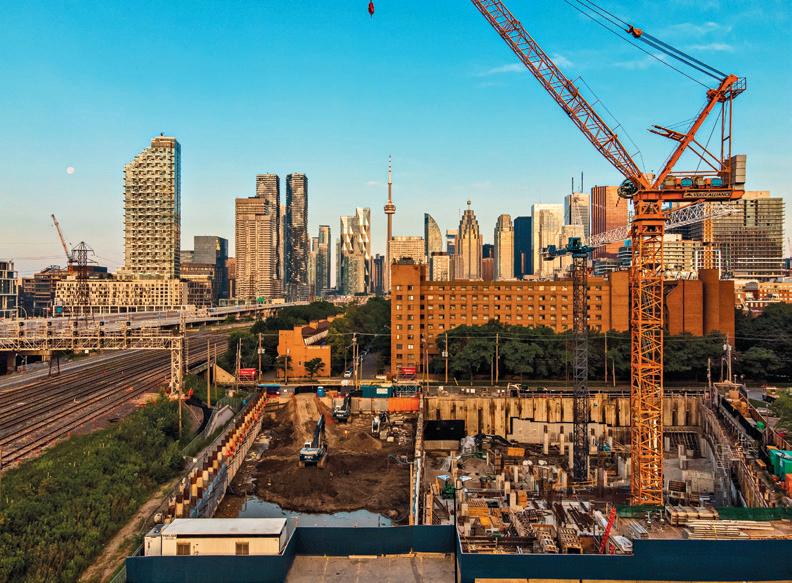
Minority governments and global uncertainty make progress more challenging, but collaboration remains the only path forward. Every level of government has a role to play, from setting national priorities and funding, to establishing planning frameworks, to managing zoning and permits. When governments work together, approvals are streamlined, infrastructure keeps pace, and more housing options become available for residents.
The message is simple: If we want more homes, more choices and greater affordability, governments must act boldly. TRREB continues to advocate for practical solutions that will deliver the housing GTA and Ontario residents deserve.
Housing remains one of the defining issues of our time, and the decisions made today will shape the opportunities available to generations tomorrow.
Conversations such as this one remind us that progress is possible, but only with commitment and action from every level of government.
Elechia Barry-Sproule is President of the Toronto Regional Real Estate Board (TRREB) and Broker/Owner of Red Apple Real Estate Inc. She is committed to mentoring and supporting real estate professionals across the industry. trreb.ca.

We’ve all seen colour trends come and go, however, one colour that always seems in trend in blue. Why is blue always so popular? It’s a timeless colour that can evoke a certain calmness to a space and yet still be dramatic. It’s inviting, tranquil, bold and yet serene… and with so many options can be the perfect statement maker. However, with an endless selection of options, the question is: Which blue should you use?
Lighter blues adds a certain freshness and serenity to a space. They can work just as a neutral would
and pair great with most all wood tones and colours; this could be a great choice for hallways, kitchens or bathrooms to name a few. A light blue can add just a hint of colour to a room and be a great alternative to a simple white, especially in a sun-filled space. A couple of light blues I’m always drawn are Benjamin Moore’s Constellation (AF 540) or Windy Sky (1639) and Sherwin Williams Dew Drop (SW 9641).
The mid-toned blues have great warmth and life to them. They are very versatile for so many different
by LINDA MAZUR
styles and aesthetics and can be ideal for feature walls, millwork, colourdrenching a space or layering within a space. Mid-tones add a certain energy to a space, while surprisingly still being relaxed and calming. They can be great for a bedroom, or your main living and dining spaces. Some of my favourite mid-toned blues are Sherwin Williams Distance (SW6243) and Blustery Sky (9140) or Benjamin Moore Santorini Blue (1634) and Stillwater (1650).
Deeper toned blues can be rich and dramatic. These classic blues define a




space, adding interest, moodiness, luxury and a sense of sophistication. They pair well with a multitude of colours and work great as a millwork option, in a powder room or perhaps a home office. My favourite darker blues are Benjamin Moore’s Gentleman’s Gray (2062-20), and Navy Masterpiece (1652), or Sherwin Williams Charcoal Blue (2739) or Rainstorm (5230).
Blues are versatile, and with so many options you’re bound to create a space that reflects your personality and style. Some things to consider when selecting your blues are lighting, whether natural or artificial, location, the desired mood of the space, will it be a focal point or used as an accent colour throughout, and finally how committed are you to your choice of blue. How or wherever you decide to use blue in your home you are sure to create a welcoming and impactful space that will be stylish for years to come.

Linda Mazur is an award-winning, nationally publicized designer and Principal of Linda Mazur Design Group. With almost two decades of experience this in demand multi-disciplinary design firm is known for creating relaxed, stylish spaces and full-scale design builds within Toronto, the GTA and throughout Canada. lindamazurdesign.com @LindaMazurGroup

A beautiful home starts with smart space planning. Beyond finishes and square footage, it’s how each room functions and adapts gracefully to the needs of tomorrow, that determines how well it supports everyday life.
The best floorplans begin with lifestyle. Ask yourself: How will this room be used? For some families, that may mean accommodating

multiple generations under one roof. For others, it’s creating spaces that flex between work, leisure and family gatherings. In a recent model home, we added a shower to a main floor powder room, instantly transforming the livability of the entire floor. Flexibility is key.
Tip: Think about how your family’s needs may evolve; today’s office could be tomorrow’s bedroom or study space.
by MARIAM ABOUTAAM
Dividing a home into “zones” allows each area to serve a defined purpose while leaving room for change. A favourite item we’ve included in Kylemore’s model homes is adding a built-in banquette in the kitchen which then becomes a spot for breakfast, after-school snacks, homework or family games. Installing ceiling details, such as decorative molding or lighting, helps


define dining and living areas while keeping the space visually cohesive.
Furniture plays a significant role in how a room functions. For example: Round dining tables encourage conversation and make circulation easier.
Tip: Don’t let furniture block natural pathways – leave at least three feet of clearance for movement.
Scale is important. Oversized furniture can overwhelm, while undersized pieces leave rooms feeling unfinished. The right balance helps create comfort and is welcoming.
Tip: Consider placing a sofa away from the wall to free space for a desk, console table, artwork or lighting, while making the room feel more inviting.
Well-planned rooms allow for multiple activities to occur simultaneously. A media room can include built-in cabinetry for TV viewing while offering

cosy spots for reading or conversation. In open-concept layouts, strategic placement of furniture maintains circulation while providing balance.
In homes with many residents, the primary bedroom often becomes a personal sanctuary. In a recent model home design, I extended a custom headboard around the room flowing into a built-in chaise. The layered textures and colours elevated the design while creating an inviting corner nook for lounging.
Space planning is about foresight. Families grow, needs shift and lifestyles change. By blending functionality with flexibility and paying attention to scale and flow, your home will remain as comfortable and welcoming in the future as it is the day you move in.
In my next column, I’ll be discussing where and what type of fireplaces to consider, to cosy up any room.

An award-winning in-house designer, Mariam
is Director, Sales and Marketing, Interior Design at Kylemore, Markham, Ont., a builder known for masterplanned communities and luxury homes. kylemoreliving.com.
The
1. Bristol place 199 Main St, North, Brampton
2. Duo condos Malta ave & Steeles Ave
3. Mayfield Collection 2256 Mayfield Road. Mayfieldcollection.ca
4. Curio Condos 801 The Queensway marlinspring.com
5. Humberwood Heights 50 Humberwood Blvd. tributecommunities.com
6. Arcadia District Bloor & Kipling arcadiadistrict.com
7. Kül Condos 875 The Queensway kulcondos.com
8. Panda Markham 8200 Warden Ave. lifetimedevelopments.com
9. Gallery Towers at Downtown Markahm 162 Enterprise Blvd. downtownmarkham.ca
10. Highmount 4077 Hwy. 7 highmountbykingdom.com
MISSISSAUGA
11. Birch at Lakeview Village Lakeshore & Dixie Rd. branthaven.com
12. Artform Condos 86 Dundas St. E. emblemdevcorp.com
13. Exhale Condominiums Lakeshore Rd. East & Dixie Rd. exhalelakeshore.ca
14. Westport 28 Ann Street westportcondos.ca
15. Central Park Sheppard Ave. East & Leslie St. amexon.com
16. Yonge City Square 4050 Yonge St. yongecitysquare.com
PICKERING
17. Vupoint Kingston Rd. & Liverpool Rd. tributecommunities.com
OSHAWA
18. U.C. Tower 2425 Simcoe St N,Oshawa tributecommunities.com
TORONTO
19. Lawrence Hill Urban Towns Don Mills & Lawrence lawrencehillurbantowns. com
20. 489 Wellington St. W. 489 Wellington St. W. lifetimedevelopments.com
21. 500 Dupont St. 500 Dupont St. lifetimedevelopments.com
22. Artistry Condos 292 Dundas St. W. tributeartistrycondos.ca
23. Panda Condos Yonge & Dundas. lifetimedevelopments.com
24. 36 Eglinton Ave. W. 36 Eglinton Ave. W. lifetimedevelopments.com
25. Linx Condominiums Danforth & Main tributecommunicties.com
26. Y&S Condos 2161 Yonge St. tributecommunities.com
27. 50 at Wellesley Station
50 Wellesley St. East pureplaza.com
28. No. 1 Yorkville 1 Yorkville Ave. pureplaza.com
29. Theatre District Residences Adelaide & Widmer pureplaza.com
30. Bijou on Bloor 2450 Bloor St. West pureplaza.com
31. The Briar on Avenue 368 Briar Hill Ave. pureplaza.com
32. One Seventy Spadina & Queen St. West pureplaza.com
33. King West & Charlotte King St. West & Charlotte pureplaza.com
34. Forest Hill Private Residences
2 Forest Hill Rd. foresthillresidences.com
35. Oscar Residences 500 Dupont St. W. at Bathurst oscarresidences.com
36. Kingside Residences Kingston Rd. & Danforth altreedevelopments.com
37. Allure Condominiums 250 King St. East emblemdevcorp.com
38. XO Condos King & Dufferin lifetimedevelopments.com
39. 225 Jarvis Street Condos Dundas St. East & Jarvis amexon.com
40. 101 Spadina Spadina & Adelaide 101spadina.com
41. The Residences of Central Park Sheppard Ave. East & Leslie centralparktoronto.com
42. The Dawes at Main Street Danforth & Main St. thedawes.com
43. Birchaus Birchcliffe Village on Kingston Road birchausresidences.com
44. Knotting Hill 4000 Eglington Ave. W knottinghillcondominiums. com
45. Park Avenue Place 1 & 2
Jane St. & Rutherford Rd. solmar.ca
The latest properties in the Southwestern Ontario Area to keep your
1. Affinity Condos Plains Rd. E. & Filmandale Rd. rosehavenhomes.com
2. Millcroft Towns Appleby Line & Taywood Dr. branthavenmillcroft.com
3. North Shore North Shore Blvd. & Plains Rd. nationalhomes.com
FORT ERIE
4. Discoverie Condos Signature Communities discoveriecondos.ca
HAMILTON
5. 1 Jarvis 1 Jarvis 1jarvis.com
6. The Design District 41 Wilson Street emblemdevcorp.com
7. Corktown 225 John Street South corktown.condos
NIAGARA
8. Lusso Urban Towns Martindale Rd. & Grapeview Dr. lucchettahomes.com
9. The Greenwich Condos at Oakvillage Trafalgar Rd. & Dundas branthaven.com
10. Synergy McCraney St. E. & Sixth Line branthaven.com
11. Upper West Side at Oakvillage 351 Dundas St. E. upperwestsidecondos2.ca
12. Greenwich Condos at Oakvilage Trafalgar Rd. & Dundas St. branthaven.com
13. Villages of Oakpark Dundas & Trafalgar ballantryhomes.com
STONEY CREEK
14. Casa Di Torre 980 Queenston Rd. branthaven.com
15. On The Ridge Lormont Blvd. & Chaumont Drive liveontheridge.ca

































































With high utility costs, more homeowners are looking to cut energy bills – and smart renovations are a great place to start. Prioritizing energy efficiency in your next project can lead to long-term savings and a more comfortable home. Upgrading your home with energy-efficient windows, insulation, and HVAC systems not only reduces energy consumption and lowers utility bills, but also helps cut the emissions that drive climate change.
Before you start your renovation, schedule a home energy evaluation with a registered energy advisor. An energy advisor will conduct a thorough assessment of your home, measuring and collecting data about all the elements that impact its energy performance, from airtightness to insulation, to heating and cooling systems. Once the assessment is complete, you will receive a report (or label) with a rating of your home’s energy consumption. The report will show the proportion of energy consumed by each system in your home and will compare your home’s performance to that of a typical new house.
The energy advisor will also give you a renovation upgrade report, with a customized action plan to improve the energy efficiency of your home, and will complete any forms required to receive any applicable rebates from utility companies or government programs that may be available. When your renovation is finished, you can

another assessment to see how your home is performing and obtain a new EnerGuide rating.
BetterHomesTO, a BILD partner, provides rebates and incentives for home energy efficiency upgrades, including the city’s Eco-Roof Incentive and Home Energy Loan Program, Enbridge’s Home Efficiency Rebate, winterproofing and Smart Thermostat programs, and the Ontario Energy Board Low-Income Energy Assistance Program. You will also find a savings calculator that will help you determine how much energy you will save with certain upgrades.
If you are looking for a renovator who can guide you in making your home more energy efficient, I encourage you to work with a renovation professional who is part
of the RenoMark program. RenoMark renovators commit to a code of conduct that requires them to offer a minimum of one-year warranty on all work, carry a minimum of $2 million in liability insurance and provide a detailed written contract. To find a RenoMark renovator in your area, visit bildgta.ca.
Dave Wilkes is President and CEO of the Building Industry and Land Development Association (BILD), the voice of the homebuilding, land development and professional renovation industry in the GTA. For the latest industry news and new home data, follow BILD on Twitter, @bildgta or visit bildgta.ca.

